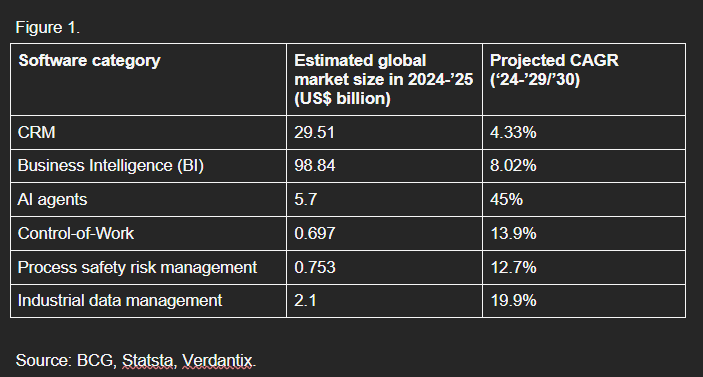Industrial software for long has lagged the sector-average growth of the rest of the enterprise software market and in sheer size. Solutions for desk workers, who are always connected and often, chronically online, draws much media interest, risk capital, and talent. Industrial software much less so.
Industrial software categories are either small or slow moving or both, relative to major and trendy enterprise software sectors (refer to Figure 1.).

Early on, we must define industrial software.
- Industrial s/w is not ERP. not just IoT, nor planning tools for capital projects. Industrial software is the toolset for those who work on site, at plants and assembly lines, with both their minds and hands. This toolset can be augmented by sensor data, but IoT or SCADA is far from the entirety of software. Industrial software is the toolset used to keep site operations safe, compliant, and efficient. A second kind of industrial software is that which helps orchestrate, monitor, and manage maintenance operations. A third kind is the planning tool that helps ops leaders figure out timelines, budgets, and schedules better for large-scale, capital projects. The fourth kind comprises platforms that bring all operational data into one place, semantically linked, enabling better decision making.
- Industrial software is not just drones and satellite imagery. While flying drones around giant tanks and pipes in industrial areas and running ML algorithms on IoT data for predictive maintenance are important sub-categories, it’s factually inaccurate to think they constitute the bulk of industrial software.
- Industrial s/w is that which manages last mile processes. Discourses on industrial software typically count ERP, IoT, supply chain planning and a whole host of software that indeed monitor and measure manufacturing processes but overlook last mile processes. Some of these last mile processes are indeed covered by categories such as enterprise asset management and manufacturing execution systems. But their utility is limited to decision makers.
- EHS and its many variants are a small subset of industrial software. There’s yet another category of software that is compliance focused such as EHS and its many variants. These indeed overlap some with on-site industrial operations, but mostly from the point of view of compliance. These categories are about record keeping of controls, not efficiency. This is the gap in the market Maximl addresses.
Industrial software, like all other B2B software, is about being a system of record for a particular function, and a platform for orchestrating work in that function. Any enterprise software category is a mix of data models, analytics, workflow, rules, and UX that works for the target audience (TA).
The bulk of work in the industrial arena is maintenance, repair, refurbishing – its planning, scheduling, and execution. The information system for managing the above is industrial software.
It’s to be noted that the work here is executed by the industrial worker, and the plant manager. Not those in corporate HQs.
Even the giants that built the ERP ecosystem over the last 35 years rarely extend their footprint to the last mile industrial worker. Over the decades ERP core has come to encompass the supply chain and manufacturing logistics, but the end goal is to provide updated information on man and material to decision makers. More on this later, but last mile industrial work (imagine the man in a hard hat wearing a visibility jacket, atop a scaffold 40 feet above ground) presents some difficulty in terms of capturing data from the site of work execution (the scaffold) for the benefit those at the site of work management (the office).


